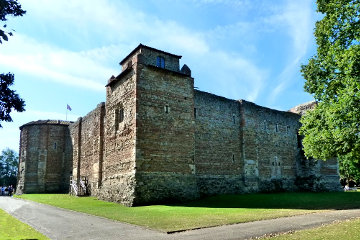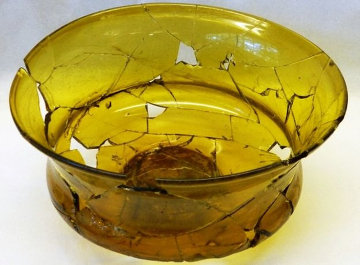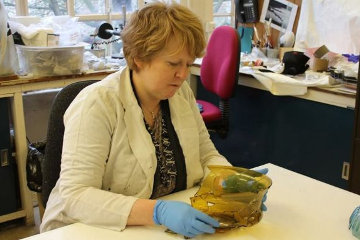A Resigning Matter!
According to Gilbert and Sullivan, a policeman's lot is not a happy one - but compared to the lot of the Colchester Museum conservator, policemen are not only sitting pretty, they are sitting pretty in clover. Lots of it.
And the source of all this angst?
A Roman bowl - a glass Roman bowl.
The misfortunate bowl was discovered in 1988 during excavations at Stanway, near Colchester, where archaeologists discovered a late Iron Age Romano-British burial site. Needless to say, time had not been kind to the person in the grave. His bones were squashed by the weight of earth pressing down on them over 2,000 years, his rib-cage flattened, his feet forced sideways, his gravegoods broken.
Among the squashed objects at head and foot were a pile of yellow glass fragments. Emma Hogarth, the despairing conservator, describes it as "absolutely smithereened", a neologism she hastily explains as "a technical term". I disapprove of turning verbs into nouns, but one does get the idea that the once splendid glass bowl was not in a usable condition.

| |
| Colchester castle keep is built on the foundations of the Roman temple in honour of the Divine Claudius, the conqueror of Britain. |
Emma Hogarth's predecessor undertook the delicate task of sorting out these shards of shattered glass and deciding which piece went with which and where. The result was a triumph - a splendid glass bowl about 9" across with vertical sides and a slightly flared lip. "It's not a very common type," Ms Hogarth explains. "You can see an example of it in a wall painting in Pompeii", but no other examples have been found in northern Europe.
Unfortunately, either Ms Hogarth's predecessor was less skilled or the glues available in 1988 were less robust than was hoped. After a mere eleven years on display the glue had dried out sufficiently that a few pieces dropped off the bowl and lay accusingly on the floor of the display case. Emergency repairs were undertaken, but when further pieces came apart the decision was taken to carefully dismantle the bowl and put it back together using modern glue.

| |
| The Roman glass bowl in Colchester museum after it was repaired for a third time in 2014. |
This was all part of a major refurbishment of Colchester Castle that cost £4.2 million, so I suppose the added cost of regluing the bowl was hardly noticed. The work, which was completed in 2014, took fifteen months and the result was a splendid modern museum with all sorts of interactive displays and the usual sort of gimmickry that is thought essential in order to attract an ignorant public whose one desire is to be entertained, not educated.
In one of the cases stood our hero, the yellow glass bowl, and to emphasise to the gawping public that it had been found in a grave the museum curators placed a skull on the shelf above it. (Whether the skull was in any way related to the original grave I have not been able to find out.)

| |
| Conservator Emma Hogarth studies the partially restored Roman bowl as it was reassembled in 2014. |
Alas, a mere twelve months later the shelf on which the skull stood proved unequal to the task and quietly broke. The skull dropped and landed on the bowl, reducing it once more to smithereens - and this time rather more smithereens than there were originally. In fact, in a few cases the glue has proved stronger than the parent glass and there are fragments still glued together but broken in new ways.
The result is that Emma Hogarth's task is vastly more complicated than it was before. It is no longer clear where each piece should go and she is using low-adhesive masking tape to hold pieces together but allow them to be easily taken apart if it turns out that this piece does not go with that piece but belongs to another piece entirely. Only when she is satisfied that she has correctly reassembled the bowl will she take it apart for the last time and glue the pieces firmly in position.
At least, she hopes it will be the last time. A reporter, with ghoulish jocularity, asked her what she would do if the ill-fated vased was brought back to her a third time.
"I think I might resign," she said firmly.
Colchester Castle When Claudius conquered Britain and incorporated it in the Roman Empire he decided to make Colchester the capital of Roman Britain. The location was the capital for a major British tribe, the Catuvellauni, whose recently deceased king, Cunobelin, controlled much of southern Britain. It had a good harbour and the people seemed disposed to be friendly. As a mark of favour the Romans not only established Camulodunum as a colony - Colonia Victricensis - but they built a large temple to the Divine Claudius, the largest classical temple in Britian.
When Boudica revolted twenty years later she and her warriors made a beeline for Camulodunum, which, like the rest of Roman Britain, was totally unprepared for the situation. The soldiers and as many civilians as possible rushed to the temple, whose solid, bronze-coated doors and windowless walls offered the best available refuge. They held out for two days before the hostiles broke in and massacred them all.
When the Romans regained control of the area they rebuilt the temple and it continued in use until the mid-300s when it was substantially remodelled. The changes have been interpreted as the temple being converted for use as a Christian church.
When the heathen Saxons invaded the church was no longer used and gradually decayed into ruins, but its solid undercroft remained and four years after the Normal Conquest, Gundolf, bishop of Rochester, decided to use it as the foundations for a fortress - it saved all the work and bother of building a motte on which to erect the castle. The result was that Colchester's keep is the lagest ever built in Britain - 152'x112', the dimensions of the Roman temple.
After passing through various vicissitudes, including being sold to a local man to be demolished for building stone, the castle is now one of Colchester's main tourist attractions and houses a fascinating museum which I thoroughly enjoyed visiting a few years before the latest refurbishment. Return
© Kendall K. Down 2015





